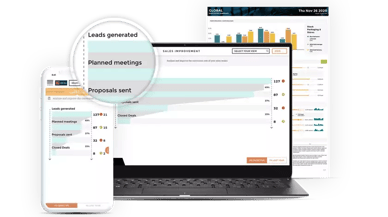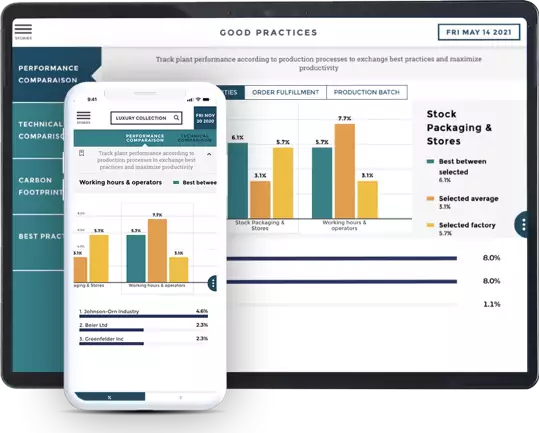KPIs, or a Key Performance Indicators, are measurable metrics that are used to evaluate how successful a person , team, or organization is at reaching a target. KPIs can be high-level, looking at things like business performance, or more granular to track the success of individuals or departments.

KPIs, when used effectively, can help managers, employees and entire organizations better assess and optimize what they do. Ultimately, KPIs are vital to facilitating any successful business strategy.
But how can we give meaning to KPIs? What should we use? How can we navigate the massive amount of data that is available today?
In this article, we'll go over:
- Why you need KPIs to build a successful team
- Some techniques you can use to set up your KPIs
- How to use KPIs as a tool for sharing information across your organization
Peter Drucker, considered to be one of the founders of Modern Management, once said :
“You can’t control what you can’t measure.”
And it's true! You can't possibly improve (consistently) without setting clear and measurable goals. So, let's dive a bit deeper:
KPIs: The KEY TO SUCCESS IN YOUR BUSINESS
...but first a reminded:
What is a KPI?
Definition: A KPI is a performance indicator for your business that allows you to track the effectiveness of action against pre-defined objectives. A KPI can take different forms: growth in turnover, absenteeism, market penetration, the list goes on and will differ across industries, companies, departments, and individuals.
There are usually two types of KPIs within teams. The former is in close connection with the activity of the service or company – activity metrics.
For instance: the number of employees trained in new working methods, the number of products released by the Research & Development department over the first six months of the year.
The second category of indicators concerns the effects of your actions on the market – impact metrics.
For instance: Your market share in a given category of products, the sales within your e-commerce site, or your churn rate.
DEFINING YOUR KPIS: A MANDATORY STEP

KPIs are useful for all everyone in a company (if intelligently defined and shared). They are the first step to effectively managing your activity, evaluating your competitive positioning, and identifying areas for improvement.
Step 1: Determine the needs to which they respond
Example: I need to analyze my sales throughout the year.
Did my sales increase over time? Do I want to compare my current sales against the same period the previous year? Do I want to view the details of my sales on a product-by-product basis or do I prefer to see the performance of my salespeople on a case-by-case basis?
Upstream thinking is essential; it needs to be investigated further to determine relevant indicators.
Step 2: Indicators should be aligned with the company’s strategy and objectives
Example: If you want to increase your sales by 15% in the next quarter, the chosen indicators should help you identify success factors that drive your strategy forward.
Step 3: The indicators should provide action plans.
An indicator thats not actionable is useless.
Example: Good KPIs will enable you to immediately identify what actions you can take to improve them and, consequently, your business. Let's say your sales have increased by 20%. With this data, you should be able to find out why: the chosen indicators will reveal actions to pursue (or to stop) in order to increase the sales.
To summarize: if your indicators correspond to precise needs, they will necessarily be aligned with your strategy and objectives. Thus they will give you action items.
A piece of advice: measure only what you need to track your quarterly and annual goals.
Feel free to share your ideas, your indicators to discuss and evaluate their relevance. Your employees also need to feel involved in this process. After all, they will reflect their daily work.
KPIS: SHARE THE INFORMATION!

The indicators put in place by your employees must be your strength. They are an inherent part of efficient teams.
Being able to measure your progress in relation to your objectives allows to share information and to ensure everyone is working towards the same goals.
These goals are sure to be a conversation starter and make meetings more actionable. You have concrete data and results to present. These indicators are also a way to evaluate the quality of the work of an employee. It is, therefore, a good opportunity to support the team to achieve the next goals.
In this regard, we have to remind you how much the educational efforts and the way of communication are important: demonstrate empathy towards employees!
From autonomy to more responsibility
Your employees need autonomy in their work. Most of them do not need to be watched all day long.
The introduction of relevant indicators is a step in this direction: employees are empowered. Then they will feel involved and will be eager to get the best results possible.
Simplicity is good, less is more
A little point of attention: when manipulating a lot of data, we tend to multiply the number of indicators to be tracked. The best is the enemy of the good. Many reports are overloaded with data, although it is not easy to understand each of the indicators presented.
To set up a reporting, we first need to ask ourselves whether the number of KPIs to present is relevant to keep everybody’s attention.
P.S. we touched on this in another article: How to choose the right graph for your data?
Today, there is a multitude of Business Intelligence tools that allow you to simply aggregate the data to make it readable and understandable quickly.
Keep in mind that these KPIs are just a way of understanding what works and what does not work and making the right decisions quickly. Take a few moments to use, to understand and to benefit from the valuable lessons that can be learned for your strategy.





